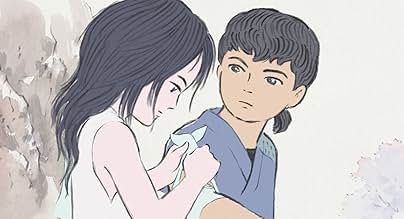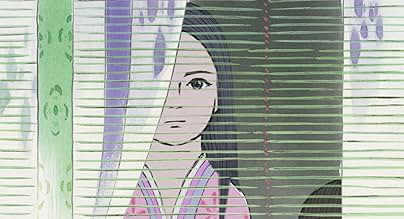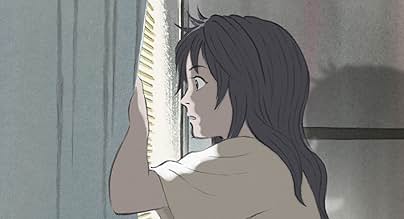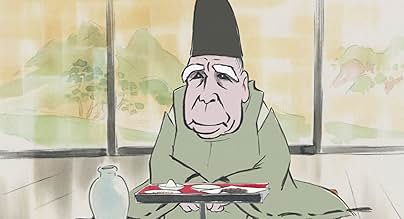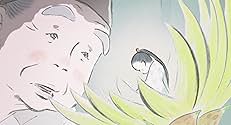Nel profondo di una foresta di bambù, Okina, un'anziana contadina, trova un gambo di bambù misteriosamente incandescente, che dall'interno emerge una minuscola creatura.Nel profondo di una foresta di bambù, Okina, un'anziana contadina, trova un gambo di bambù misteriosamente incandescente, che dall'interno emerge una minuscola creatura.Nel profondo di una foresta di bambù, Okina, un'anziana contadina, trova un gambo di bambù misteriosamente incandescente, che dall'interno emerge una minuscola creatura.
- Regia
- Sceneggiatura
- Star
- Candidato a 1 Oscar
- 13 vittorie e 38 candidature totali
- The Princess Kaguya
- (English version)
- (voce)
- The Bamboo Cutter
- (English version)
- (voce)
- The Bamboo Cutter's Wife
- (English version)
- (voce)
- …
- Prince Ishitsukuri
- (English version)
- (voce)
- Kaguya hime
- (voce)
- …
- Sutemaru
- (voce)
- Okina
- (voce)
- Ôna
- (voce)
- …
- Sagami
- (voce)
- Menowarawa
- (voce)
Recensioni in evidenza
Based on a 10th century Japanese folktale, The Tale of Princess Kaguya is a bittersweet coming of age story. Our protagonist is Kaguya-hime who is discovered as a baby in a bamboo stalk by an old peasant man. He and his childless wife raise her as their own, providing the best they can as she rapidly ages. While her mother is fearful of change and just wants a comfortable life for her adopted daughter, her father envisions great things. He sees Kaguya as part of a divine plan and after fine clothes and gold come shooting out of bamboo stalks he concludes that the heavens want her to become a proper princess. He assumes this is the best way to make his daughter happy instead of asking her what she wants.
A sharply observed feminist critique of traditional Japanese culture as well as a cautionary tale of the burdens we place on our children, The Tale of Princess Kaguya has a wealth of complex themes and archetypes hidden beneath the surface of its fairly straight- forward story. This is one of the rare films that are both easily accessible to a young audience and one that film students can write thesis papers on.
The final word should be reserved for Studio Ghibli's animation. The style used invokes something between impressionist paintings and water-colours while employing a muted palette. Ghibli moves away from traditional anime and the results are breathtaking. The hand drawn frames could each stand alone as a portrait and yet the film feels fluid. At times the animation blurs into expressionism; the brush strokes matching the characters inner- turmoil.
Easily the best animated film of the year, it's a must see for fans of the genre. Luckily North America will get a theatrical release; the English-dubbed version will be out October 17 and will star Chloe Grace Moretz as Kaguya.
I love the way animation can take such simple things as eating a melon or watching birds fly into a tree so much more exciting. By using traditional animation (although I need notice some computerize layouts),The Japanese have done it again with their personal approach to the detail of animation you can only get from 2D.
Adding to my enjoyment, this English adaption of the film includes the voice talent of Chloë Grace Moretz as the princess, who I've become a fan of.
It was very beautiful artwork moving across the big screen.
I really appreciated how much effort was put into capturing the atmosphere of the original material. I haven't read the original material so I don't know how faithful it is to the original as a story, but I also liked the things I thought the movie said about women, life, and women's place in society.
I felt like the story was dragging its feet in places. I generally expect fable-style stories to be faster so that they can appeal to a wider audience and not cause you to start questioning the surreal world.
I want to repeat it for the last time. If you want to experience a fable, there are few, if any, better options to watch.
I believe that "Princess Kaguya" is the best Ghibli film in the past 10 years because of the beautiful hand-drawn animation and touching story.
Japanese audience and critics are also very positive for this film, compared to other Ghilbi films.
Hayao Miyazaki is a genius but his recent films are always controversial since "Haul's Moving Castle".
One of the reason is that he relies on his imagination and makes light of a script. That's why quite a few people can't fully understand his recent films and sometimes blame them. ("The Wind Rises" was a tragedy in this meaning.)
Isao Takahata, the director of "Princess Kaguya", is a very good director known for "The Grave of Firefly" but not so active since "My neighbor the Yamada".
His philosophy is very different from that of Hayao Miyazaki. Isao Takahata thinks the scenario is very important and he prefers realism to fantasy.
"Princess Kaguya" is based on the Japanese oldest folklore "The Tale of the Bamboo Cutter". But Isao Takahata transforms it into a universal humanistic story by describing Princess Kaguya as a realistic girl.
This film contains many fantastic scenes and they play as good eye candies. But the brilliantly illustrated life and emotions of the heroine is the most important part in this film. And that's what the director wants us to try to sympathize.
The beautiful and artistic style of this animation is suitable for this theme. Because this apparently unfinished animation gives us the room to imagine by ourselves.
Isao Takahata says, "The animations tend to deprive children of their own imagination by pushing them someone else's fantasy. We have to make another animation which let them imagine by themselves".
I can't wait to see the responses from the worldwide audience! Hope you will like this film too!
Lo sapevi?
- QuizIn several scenes in the movie, Kaguma-Hime, Lady Sagami and Ona can be seen wearing multi-layered kimonos called Junihitoe. Both the number of layers and the coloring of the layers worn would be dictated by the occasion, status, and season the wearer is in.
- BlooperWhile the baby princess crawls to the cutter she tosses a piece of bamboo to the edge of the floor mat. In the reverse shot as she crawls back, it is missing.
- Citazioni
The Princess Kaguya: [singing] Go round, come round, come round... Come round, oh distant time. Come round, call back my heart. Come round, call back my heart. Birds, bugs, beasts, grass, trees, flowers. Teach me how to feel. If I hear that you pine for me, I will return to you.
- ConnessioniFeatured in Troldspejlet: Episodio #50.12 (2014)
I più visti
- How long is The Tale of The Princess Kaguya?Powered by Alexa
Dettagli
Botteghino
- Budget
- 5.000.000.000 JPY (previsto)
- Lordo Stati Uniti e Canada
- 974.913 USD
- Fine settimana di apertura Stati Uniti e Canada
- 54.915 USD
- 19 ott 2014
- Lordo in tutto il mondo
- 24.751.400 USD
- Tempo di esecuzione2 ore 17 minuti
- Colore
- Mix di suoni
- Proporzioni
- 1.85 : 1







